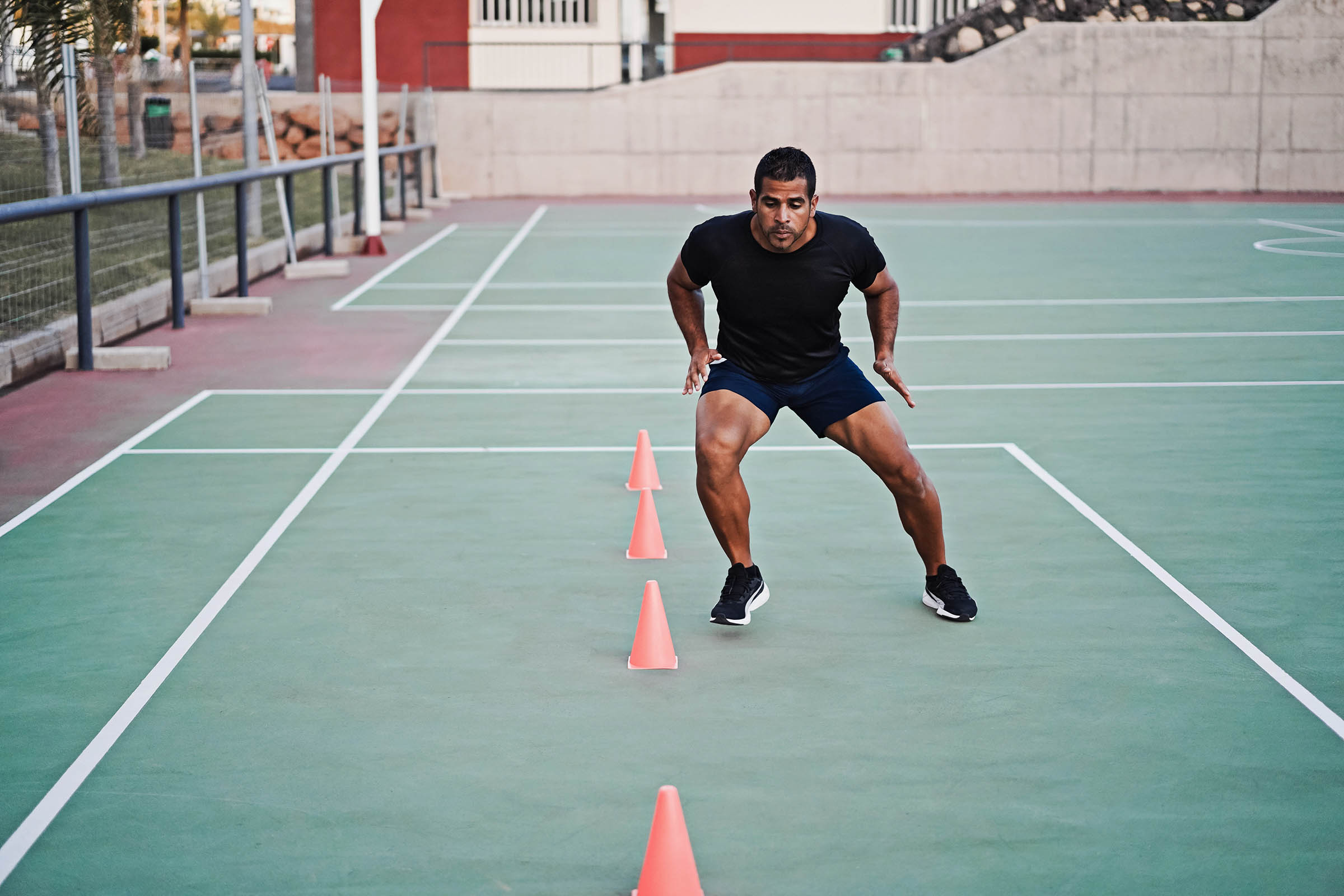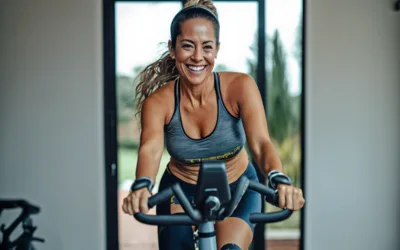Why Deceleration is an Essential Skill (Plus Drills to Work on It)

When it comes to athletic performance, learning how to pump the brakes with body control is an often undertrained skill set. Being fast is worthless without a durable, long-lasting set of brakes.
Matthew Ibrahim is an experienced S&C coach, college professor of exercise science, and a Ph.D. student in human and sports performance. He’s presented in over 20 U.S. states and several international events. Start training to stop on a dime and blow past your competition with the knowledge and drills he shares in this article.
Check out his latest program Building the Breaks 2.0 to start building elite athleticism and deceleration skills ASAP!


Change the Way You Train
Deceleration Training: Building The Brakes for Athletic Performance
Scroll through your Instagram feed under current fitness trends and you’re likely ooh-ing and ahh-ing over your favorite athletes performing ridiculously high box jumps, leaping out of a building to hit a slam dunk, or exploding past the defender in football.
All of these explosive feats of power and force production have one thing in common: they’re grounded in the athlete’s ability to pump the brakes, stop on a dime, and absorb force. But nobody seems to care about training to stop on a dime, decelerate, or land with control until they get hurt.
Injuries, whether we like it or not, are simply part of the territory in sports. However, you can do yourself (and your body) a favor by preparing the right way in your training to reduce the chance of getting hurt when playing your sport.
Elon Musk once said, “Brake pads on Tesla cars would literally never need to be replaced.” Pretty bold statement for such an expensive car. The good thing is he can back it up since the Tesla is a high-quality car built for speed and performance.
Your body, when trained the right way, is designed to be fast, explosive, and powerful. Becoming the Tesla of athletic performance means that you also have a durable pair of brakes to help you decelerate and stop quickly.
Building your brakes will not only increase your athletic performance but also reduce your risk of injury, keeping you on the field or the court longer.
The Best Athletes Are Durable Athletes
A basic key to athletic performance is being available to play your sport and help your team win. The best to do this is to stay strong and durable by reducing the risk of injury. A durable athlete is one that can recover quickly and withstand the constant demands of sport.
The highest rate of lower body injuries in athletics take place in five key areas:
- Calves
- Hamstrings
- Groin
- Knees
- Hip flexors
Keeping these five lower-body regions strong will go a long way in making sure that your body is physically prepared to consistently perform at a high level without any setbacks.
Strengthen Your Knees
How often do you strengthen your knees in your training program (besides the typical squatting and lunging exercises)? I’m guessing probably not a lot. Don’t worry, you’re not alone.
The hands-supported kneeler is a great exercise that you can easily add into your training to strengthen your knees.
When performing this movement, I recommend 2-3 sets of 6-8 reps with a big emphasis on a 3-to-5 second eccentric (lowering) component.
Get Stronger Calves
How often do you work on your calves in your training programs? Unless you’re a super-committed bodybuilder, I’ll assume you likely spend little to no time building strong calves. Again, you’re not alone here.
Keep in mind, your feet are the first thing to touch the floor when landing and absorbing force, which demands a lot from the calf muscles and Achilles tendons. Build strength and durability in this area if you want to be a beast in your sport with heels-up single-leg bridge iso holds.
It might look like a boring exercise, but don’t knock it until you try it. Lock in and perform 2-3 sets of 10-15-second holds per side.
Deceleration Drills for Explosive Athletes
Let’s jump back to the trend of being fast, explosive, and powerful. These qualities are often sexy and amazing to watch when an athlete displays them at a high level.
But just remember — athletes who can produce power efficiently can also stop on a dime efficiently. These two athletic development traits go hand in hand.
Sports take place in a variety of directions at varying speeds requiring quick reaction times. It’s in your best interest as an athlete to turn over every stone in your training. Don’t leave anything up to question, especially if you plan on playing your sport for a long time.
Deceleration skills come down to harnessing all of these athletic qualities to boost your overall performance while keeping you both strong and healthy. Whether you’re moving forward and reverse, side-to-side, or in multiple directions, decelerating efficiently means that you can stop on a dime and absorb force at any time.
Drop Reverse Lunge to Stick
Agility is a necessary skill for nearly all field and court-based sports. How often in a basketball game do athletes sprint, quickly stop, change direction, then sprint again in a completely different direction?
It’s crucial for you as an athlete to incorporate multi-directional deceleration drills in your training. Adding the drop reverse lunge to stick to your workouts helps you decelerate in the sagittal (forward and reverse) plane of motion.
Be sure to stick your landing and control your body. Aim for 2-3 sets of 3-5 reps per side in your training for best results.
Forward Alternating Close-Out
Use this exercise to build multi-directional deceleration skills.
Take your time building up a good rhythm here. This exercise isn’t about speed quite yet. First, work on feeling coordinated with the movement at roughly 75-80% effort.
Once you’ve built up some good mechanics, you can bump up into the 85-90% effort range. I recommend performing 2-3 sets of 3-5 reps per side.
Achieve Total Body Control
Controlling your body is a prime focus when defining athleticism. Think of Odell Beckham Jr.’s crazy one-handed catch with the Giants back in 2015. Masterful body control.
How about when Vince Carter jumped out of the building in the 2000 Sydney Olympics to dunk over a 7-footer? Insane. Talk about an athlete controlling his body.
I could go on and on with examples, but you get the point.
Tempo
Full-body control starts by building a base level of strength. A simple way to achieve this is by using exercises that focus on specific tempo work.
Two key areas in tempo work are eccentrics and isometrics. Eccentrics focus on the lowering aspect of an exercise to force you to slow down and take your time. Isometrics focus on owning specific body positions and building strength in them.
Why are eccentrics and isometrics important? They increase the overall time your body spends under tension. An increased time under tension equates to building strength and body control. Controlling your body boosts your athletic performance.
Coach’s Tip: For a detailed guide on how to use tempo in your training, check out Understanding Tempo Training For Maximum Strength Gains.
Heels-Up Split Squat Iso
Do this lower-body isometric exercise to increase strength and control specifically in your calves and knees.
I suggest performing these at the following clip: 2-3 sets of 20-25 second holds per side.
Plank Body Saw
This simple eccentric-focused upper body exercise improves strength and control in your shoulders, upper back, and core.
Perform this for 2-3 sets of 8-10 reps.
Find Your Perfect Training Plan
Sometimes all you need to reach your destination on your fitness journey is an expert guide. We've got you covered. Browse from thousands of programs for any goal and every type of athlete.
Try any programming subscription free for 7 days!
Want Training Tips, Exercise Guides & Knowledge Bombs Sent to Your Inbox?
Sign up for the FitNerd newsletter from TrainHeroic
Related articles
TrainHeroic’s Top Online Crossfit & Functional Fitness Programs
For CrossFit athletes who drank the Kool-Aid and have been neck-deep in the community ever since, functional fitness is the ultimate path to athletic greatness. The challenge for most meal-prepping, crew-sock-wearing, FitAid-drinking Type-A garage gym warriors is...
How Age Affects Your Training & What To Do About It
Your body naturally changes/slows down with age – there’s no denying that. But being aware and making some subtle changes to your training slows down that process. Marc Lavallee has trained Canadian military units in the Search and Rescue Technician (SAR-Tech)...
The Best Online Olympic Weightlifting Programs in TrainHeroic
Olympic weightlifting is some of the most fun and the most frustration you can experience as an athlete. If you’ve dedicated any significant amount of time to weightlifting, you know how hard it can play with your emotions... which is why we keep coming back for more....


Join the community
Sign up for the latest training news and updates from TrainHeroic


About TrainHeroic
Made with love, sweat, protein isolate and hard work in Denver, CO
© 2023 TrainHeroic, Inc. All rights reserved.






